Brief

Executive Summary
- The alternative asset management industry, which has traditionally focused on institutional investors, is now also focused on wealthy individuals, whose portfolios are underrepresented in alternatives, partly because of the highly manual, often bespoke nature of such investments.
- Tokenization can streamline, automate, and simplify most stages of alternative investments, benefiting individuals and institutions alike. It could also improve liquidity and collateralization, automate capital calls, and enable portfolio customization.
- Unlocking these benefits represents potentially $400 billion in additional annual revenue for the alternatives industry.
- While several participants in the alternatives ecosystem could develop tokenization solutions, entities with established distribution models such as wealth managers and wholesalers may be best positioned to succeed.
Closing the supply and demand gap within alternative investments
Alternative investments (alternatives) such as private equity (PE), private credit, real estate, and hedge funds can potentially enhance returns and provide diversification for investors. They are often considered more complex than traditional assets and require a longer investment horizon—in many cases, 10 years or longer. As a result, these products are primarily marketed to sophisticated institutional investors that do not have immediate liquidity needs.
Written in conjunction with
Written in conjunction with

Given the lack of common infrastructure and standards among such funds, alternatives typically have been more cumbersome to manage from an operational perspective. Alternative asset managers thus often only find it economically attractive to accept a limited number of large-ticket investments (more than $5 million) into their funds. That floor essentially prevents many individual investors from accessing these products.
Despite the historical preference for institutional investors, alternatives managers have tried to expand access to individuals for years. Bain & Company research offers insights into the forces underlying this desired expansion:
Alternatives managers face growing fund-raising challenges from institutional investors as supply exceeds demand. Consider the fund-raising results from the first half of 2023, when, according to Preqin fund-raising data, PE fund-raising supply was three times higher than investor demand—the widest gap since the financial crisis.
Individuals control over half of global wealth, but only about 5% of their wealth is allocated to alternatives. Global wealth is essentially evenly distributed between institutional investors (such as pension funds and sovereign wealth funds) and individual investors, with individuals holding approximately $150 trillion of the $290 trillion global wealth pool. (Qualified investors in most countries are those with more than $1 million in investable assets. We define high-net-worth individuals as having $1 million to $5 million in investable assets; very-high-net-worth individuals as having $5 million to $30 million in investable assets; and ultra-high-net-worth individuals as having more than $30 million in investable assets.) However, high-net-worth investors are significantly under-allocated to alternatives, with only about 5% allocated in their portfolios (see Figure 1).
Across all wealthy investors, alternative asset allocation averages about 5%
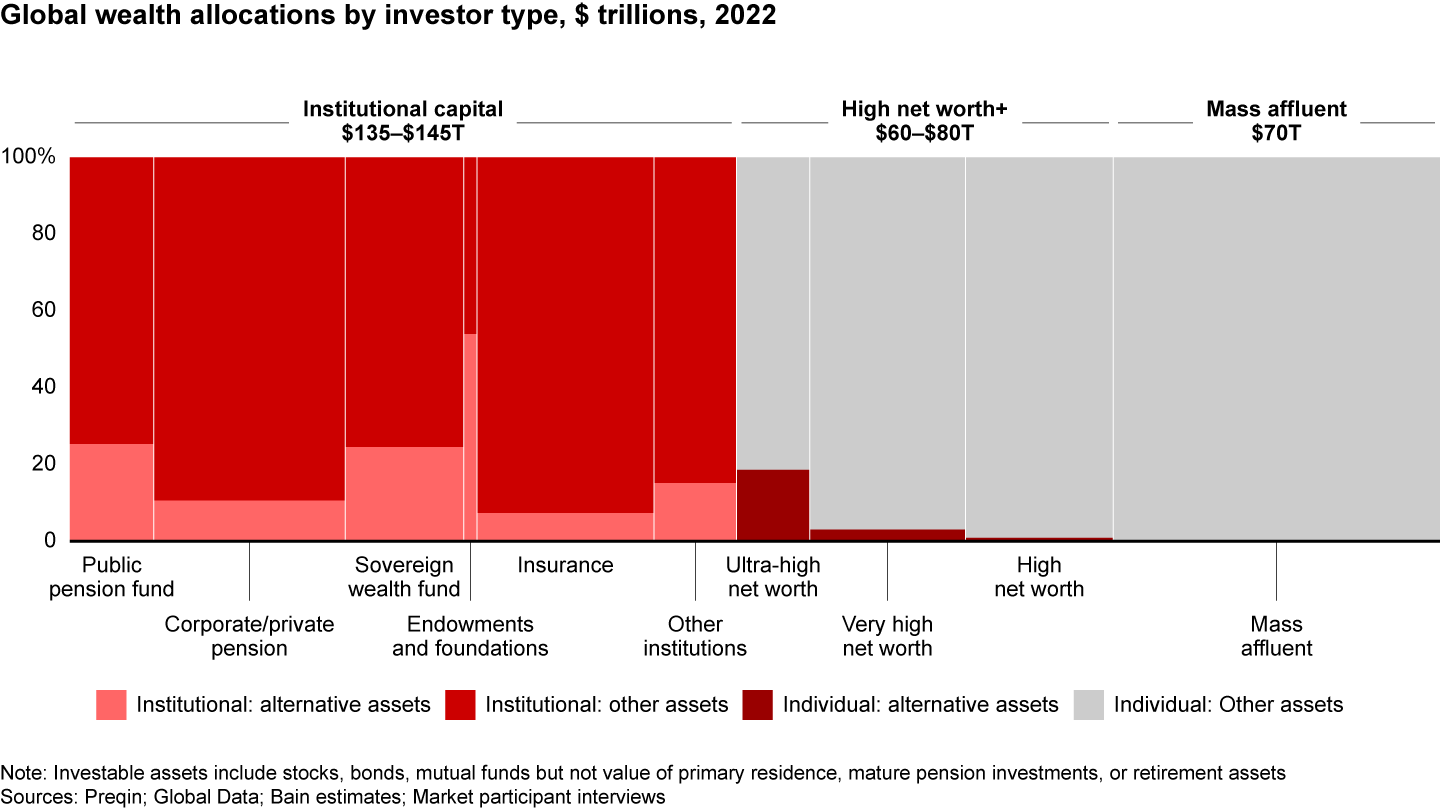
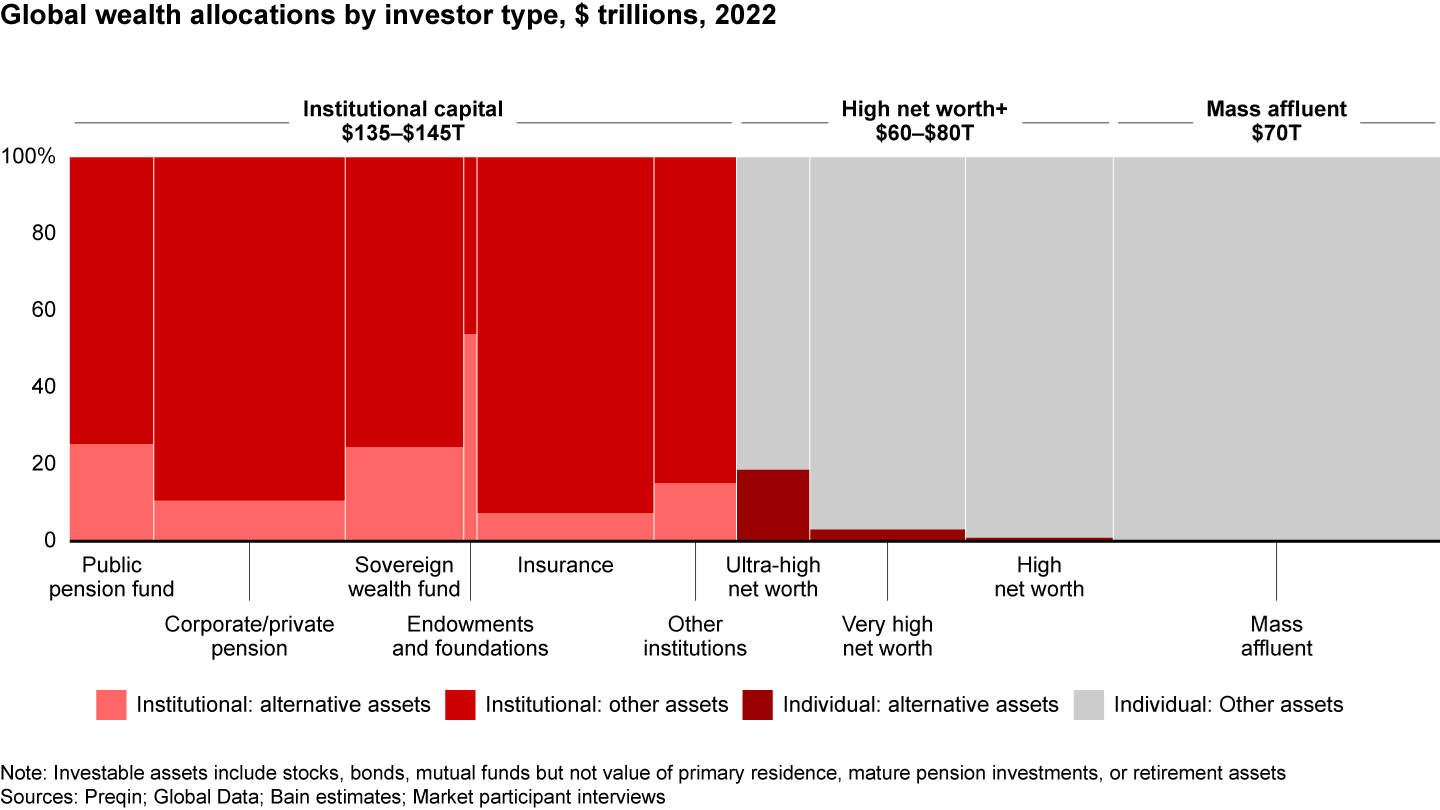
A November 2022 Bain study of 418 high-net-worth to ultra-high-net-worth individuals found that 53% of individual investors with $5 million or more in assets plan to raise their alternatives allocation over the next three years, primarily for improved diversification (60% of respondents), for higher returns (25%), and based on advisor recommendations (15%). The survey found that the main reasons to accelerate allocations to alternatives are enhanced liquidity (59% of respondents), increased holdings transparency (45%), better performance of alternatives (45%), and easier access to alternatives products (38%).
The opportunity to expand into the individual investor segment has led major alternatives managers such as Blackstone, KKR, Carlyle, and Apollo to sharpen their focus on individual investors for future growth (see Figure 2).
With alternative assets highly concentrated among institutional investors, asset managers are looking to wealthy individuals' capital to fuel growth
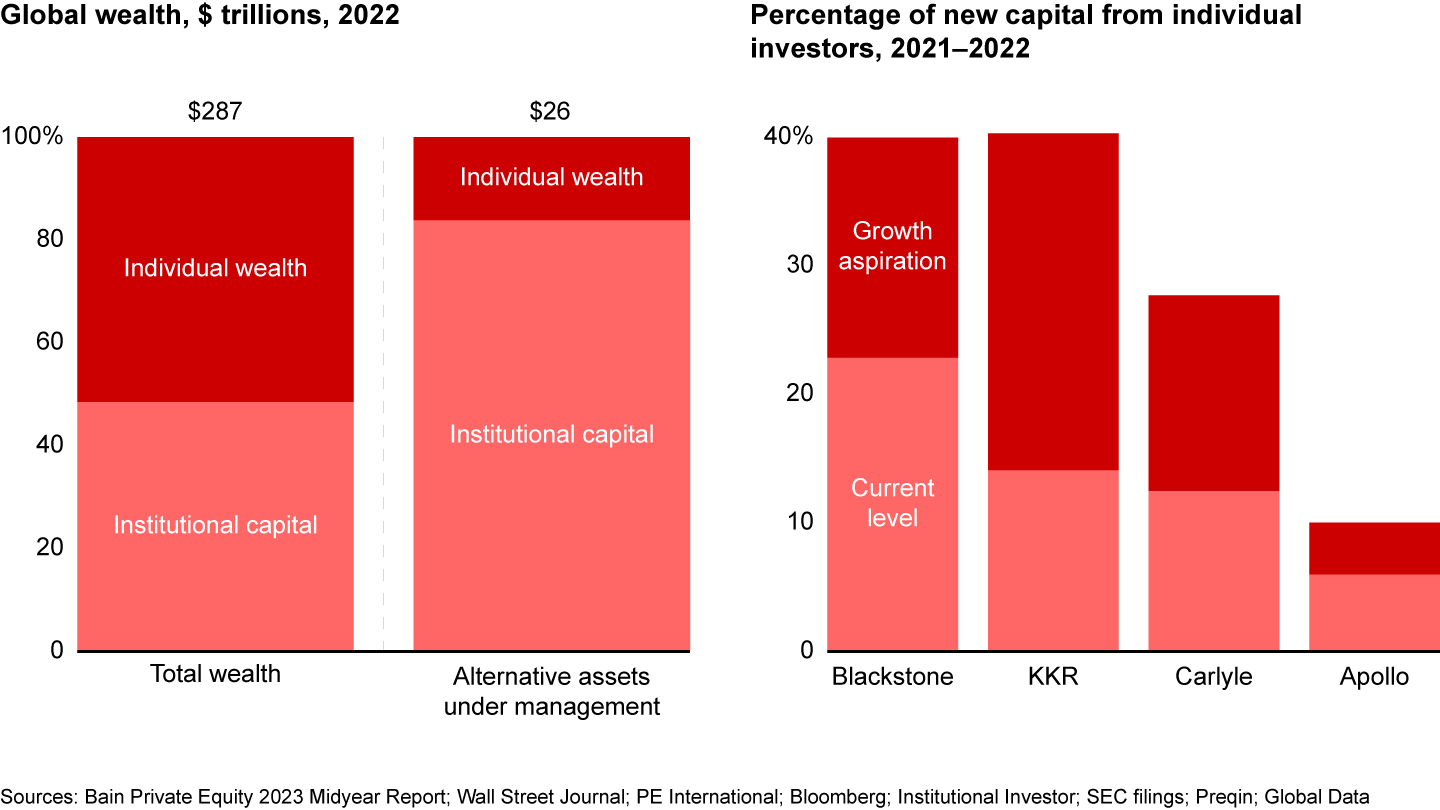
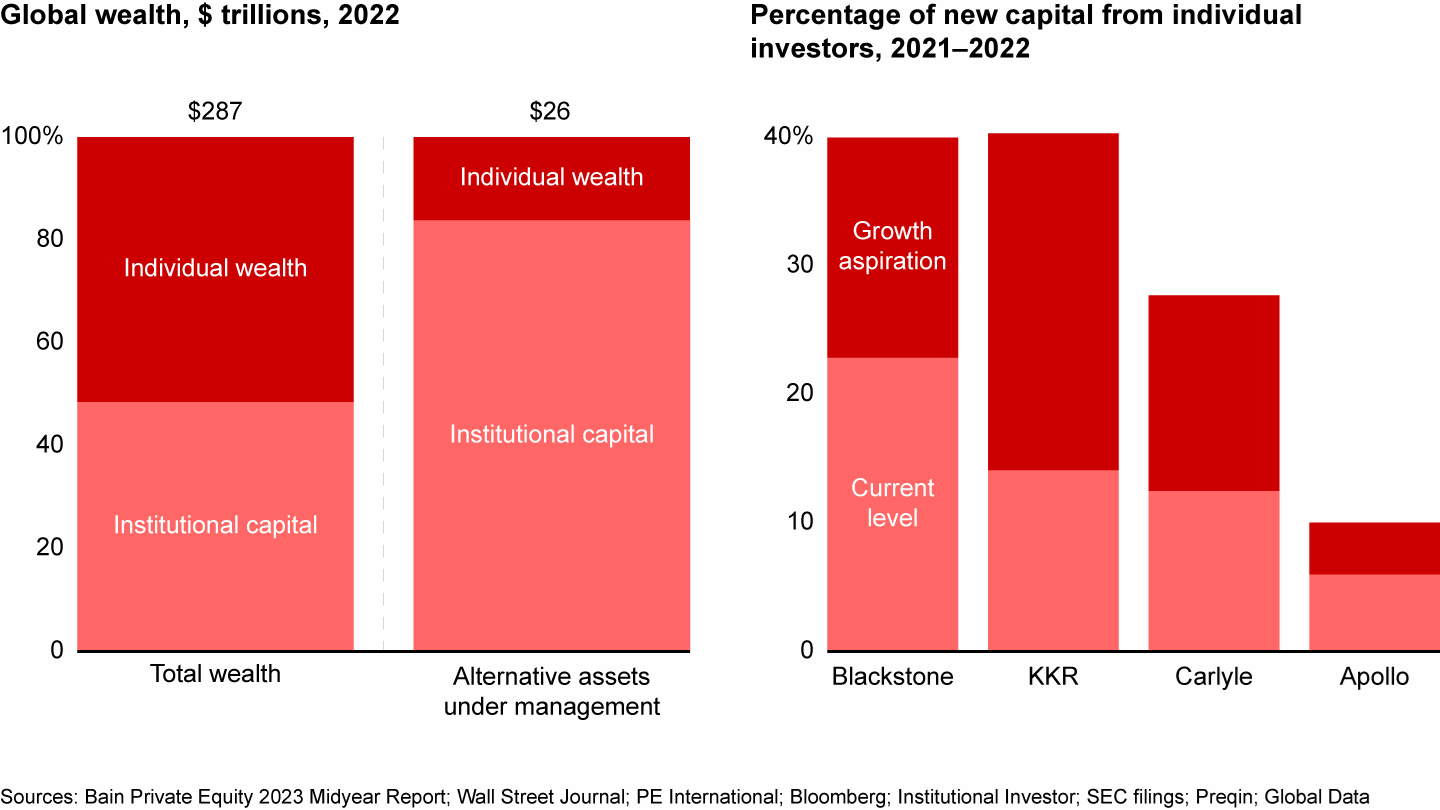
Yet despite interest on both the demand and supply sides, offering alternatives to individuals in an intuitive, seamless, and digitally native way has remained elusive.
As a result, fund managers and digital platforms have recently begun exploring tokenization of funds to expand access to individuals. These early movers are testing whether tokenization can streamline the operational processes required to distribute alternatives to individuals in a more scalable manner.
Tokenization could catalyze modern operational infrastructure, which would benefit fund managers, distributors, fund administrators, and investors through a more streamlined investment process, with the added potential for enhanced liquidity, greater borrowing ability, and customization.
While individuals stand to benefit the most given their relatively low alternatives allocations and smaller ticket sizes, these innovations could also benefit traditional institutional clients, which make up 84% of alternatives investments globally.
This paper describes how blockchain and tokenization could directly address the distribution challenges facing the alternatives industry and offers practical approaches to how tokenization solutions can achieve scale. The goal is to enable a new paradigm for robust alternatives distribution to both institutions and individuals, potentially yielding an approximately $400 billion annual new-revenue opportunity.
Complexity limits distribution to the approximately $150 trillion individual investor segment
From the perspective of asset managers and distributors, the current workflows involving alternatives are siloed and require handoffs among many participants, raising administrative burdens and operating costs. Offering alternatives is a complex business that involves many parties, providers, processes, and technology stacks, with limited standardization and automation across the end-to-end lifecycle and with each participant having their own systems. This complexity is further compounded by the variety of investment products available, each of which holds different asset classes (credit, equity, real estate, venture, and so on). Each asset class has its own nuances, including how investments are funded, how investors access their capital, and on what terms they do so. Connecting this disparate information across a broad investor base becomes more complicated and costly as the number of investors in each fund grows.
For a typical alternatives product, the key participants and providers are the following:
Alternative asset managers create and structure investment products and set distribution and investor servicing strategy. Alternatives management firms generally maintain their own sales and investor relations teams, which market the firm’s funds directly to institutional investors and through distribution platforms such as wealth managers to reach individuals.
Wealth managers and other distributors identify alternatives offerings that fit the needs of their client base, perform due diligence to assess the quality of the investment offering, structure feeder funds (if needed), and market alternatives to investors and service investors throughout a fund’s lifecycle.
Investors make the final investment decision. High-net-worth individuals generally invest based on a recommendation from their wealth manager, while institutional investors generally have their own investment teams or hire investment consultants to identify attractive investments. These investors provide capital to the fund in accordance with the fund’s terms and structure, and earn returns based on the performance of the fund.
Fund administrators and transfer agents maintain the books and records of the fund (including the investor register, unit register, and asset register); process subscriptions, redemptions, capital calls, distributions, and transfers; and maintain ownership of the know-your-customer (KYC) process.
The end-to-end process undertaken by alternatives managers typically breaks down into at least the following stages:
- Fund inception to develop the fund strategy, structure, terms, and business development plan.
- Fund setup to hire service providers (legal, fund accounting, audit, fund administration, transfer agency, banking) and structure the fund vehicle.
- Fund-raising and onboarding to develop marketing materials, initiate fund-raising efforts, process subscription documents, onboard investors, and verify anti-money-laundering (AML) and KYC documents.
- Fund operation to initiate capital calls or cash subscriptions, invest capital in accordance with fund strategy, perform fund accounting, and distribute client reporting.
- Trading and liquidity to distribute capital or process cash redemptions and consider transfer and secondary sale requests.
- Fund closing to notify investors, distribute capital as investments are realized, and maintain fund operations through final liquidation.
Across each of these participants and throughout the fund lifecycle, there are a considerable number of touchpoints, often taking place in a highly manual, bespoke manner, with multiple reconciliation points along the way (see Figure 3). This complexity results in higher costs and slower settlement times, which can hinder the managers’ ability to expand their offerings to a broader set of investors.
A standardized workflow and common platform that market participants could access would alleviate many of these pain points but has not yet been established.
The existing alternatives process has ample room to streamline and automate
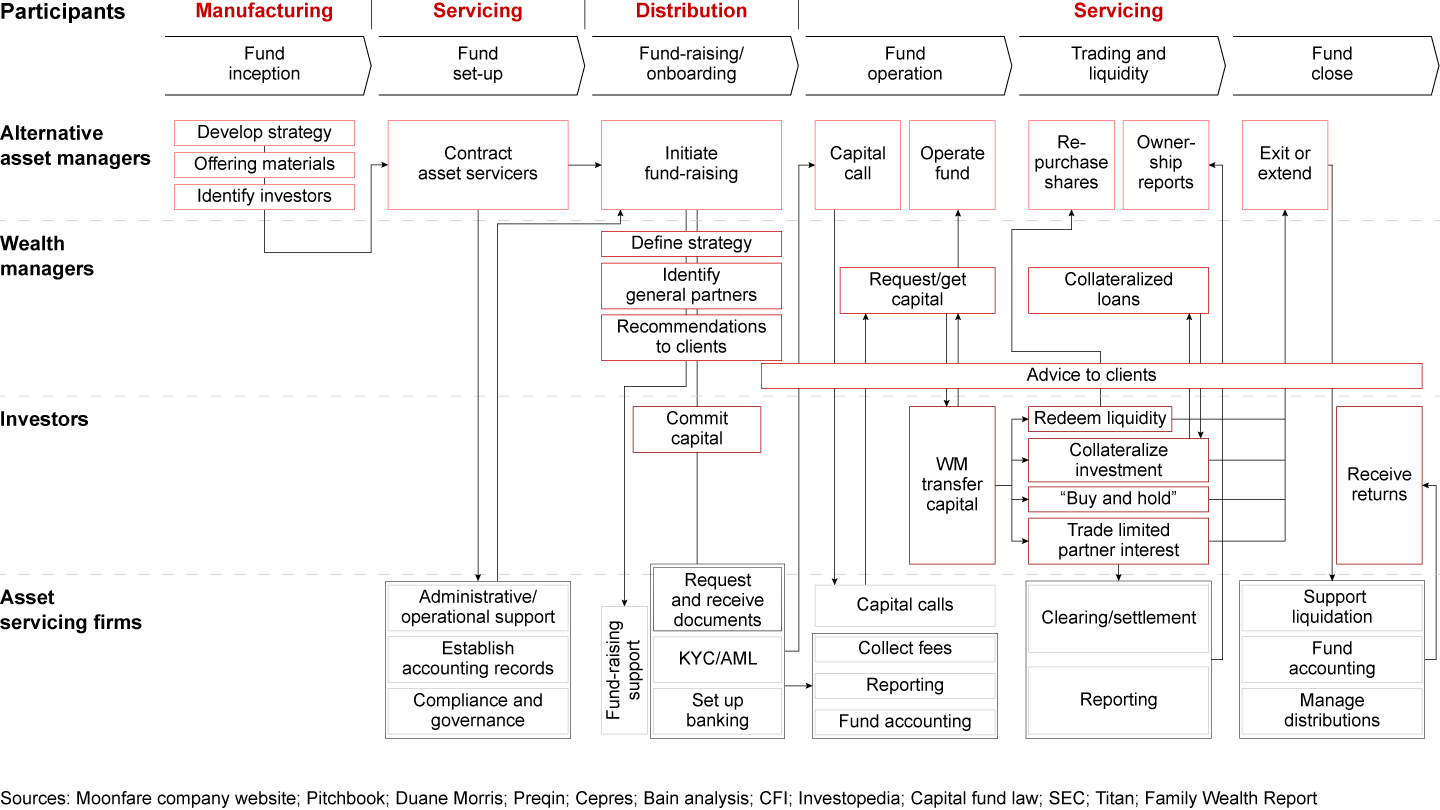
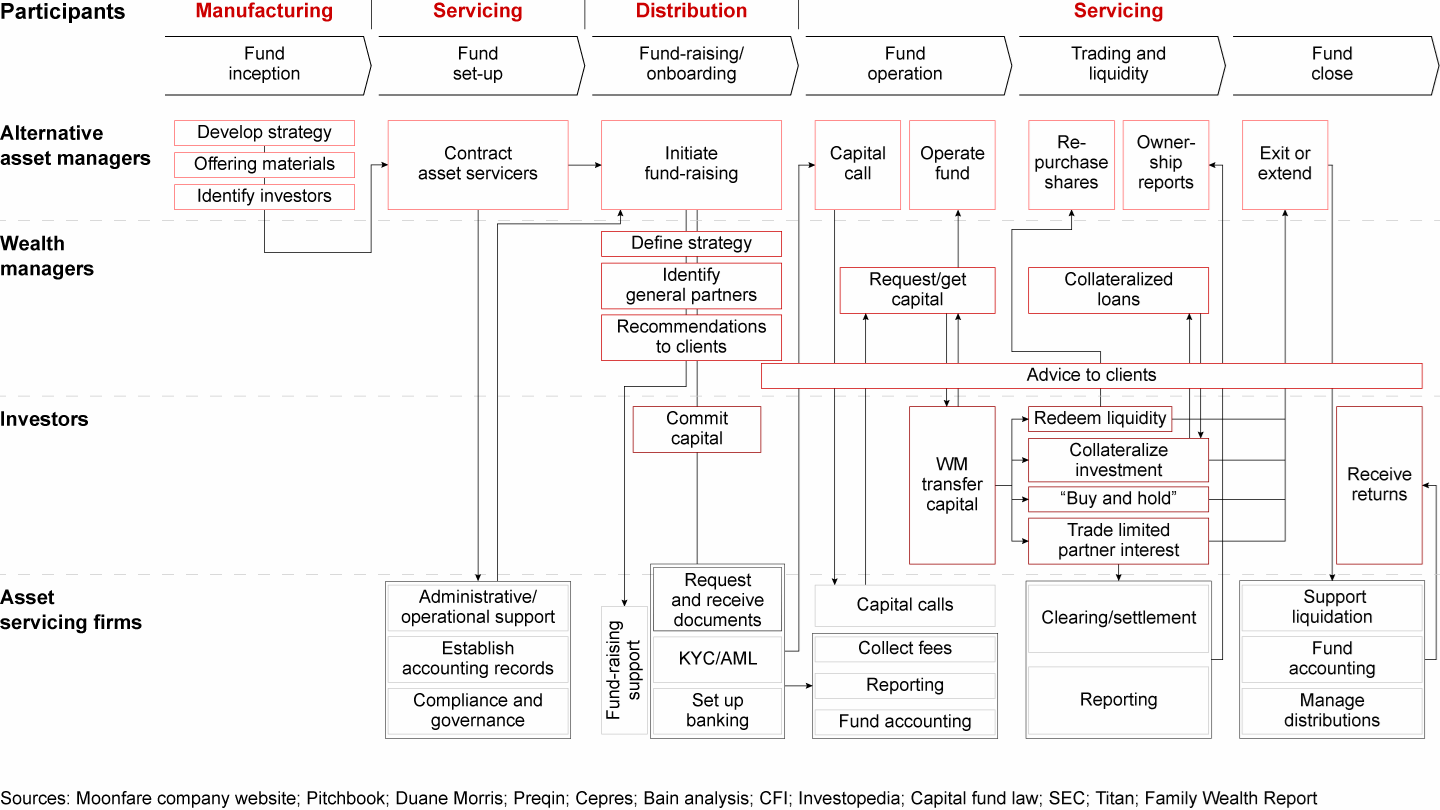
Education, access, and utility prevent adoption among individuals
While it is complex for managers to service individual investors, it is equally challenging for individuals to access alternatives.
This does not mean individuals are not interested; in fact, the November 2022 Bain study indicated that more than half of very-high- and ultra-high-net-worth individuals and nearly 40% of high-net-worth individuals plan to increase their allocation to alternatives over the next three years, mainly in expectation of improved diversification and higher returns.
Demand from this large, mostly untapped investor base clearly exists, yet several barriers impair their seamless participation in alternatives. These barriers include the following:
Education: Some 40% to 50% of individual investors in the Bain survey said limited education about alternatives prevents them from investing. Alternatives strategies can be esoteric and difficult to understand, and they often provide limited transparency to investors. This makes them one of the more difficult asset classes for distributors to sell to individuals.
Access and sourcing: Accessing alternatives can be opaque, cumbersome, and costly. There is no industry-wide marketplace, so individuals have to rely on advisors and relationships to source deals. Another challenge is that the minimum investment sizes can be $5 million or more, often too high to allow sufficient diversification within alternatives and at the overall portfolio level. In addition, certain jurisdictional regulations have criteria that define who can access which investment offerings. In the US, for example, investors must be qualified purchasers ($5 million or more in investments) or accredited investors (more than $1 million in liquid net worth) to access most nonregistered investment offerings, according to Title 17 of the Code of Federal Regulations Parts 230 and 240.
Liquidity: Current arrangements provide limited liquidity options, with the total term on PE funds often extending beyond 10 years—longer than most individual investors are willing to lock up capital. Furthermore, capital calls are unpredictable and are usually issued with short notice, making it difficult and stressful for investors to manage their liquidity.
Operational and administrative: Compared to traditional investments, the overall process of investing into alternatives can be daunting. Subscription documents are long, requiring patience and attention whether completed electronically or manually. Funding investments typically involves sending wires two to three days prior to being recognized as an investor. Fund administrators can have significant onboarding processes, and reporting is not as timely compared to that of traditional assets.
Current solutions fall short of a seamless experience
The industry’s efforts at overcoming barriers to broader access to alternatives have involved building products tailored for individuals, namely the following:
- Feeder funds shift the operational burden to distributors, while imposing additional administrative, audit, legal, and other fund costs on investors.
- Funds of funds provide diversification and reduce servicing needs, but still mostly rely on manual, disparate systems. In addition, they lack customizability and add a second layer of management fees, performance fees, and fund costs.
- Registered funds add regulatory filing and reporting burdens for managers and introduce high costs, relatively constrained liquidity, and full upfront funding that could negatively affect fund performance compared with exempted offerings.
In sum, while these products provide individuals with access, they have effectively shifted the operational overhead from fund managers to distributors, while adding costs for investors. Although helpful today, these options do not inherently have the scalability, automation, or simplicity required for a streamlined, digital, low-touch investor experience. Therefore, rather than being replaced by new solutions, these structures could be enhanced by enabling broader, streamlined distribution and reduced costs that could be passed on to end investors.
Distributors, for their part, face other barriers. Manually intensive processes create substantial administrative costs and operational risks. Fragmented systems across intermediaries require complex reconciliations that can result in delays. These firms have responded to increased volume by investing in personnel and technology systems. However, this response falls short of addressing issues of core workflow fragmentation, disjointed ownership data, and sporadic capital calls and distributions.
Tokenization offers a new, scalable approach
Tokenization and blockchain offer a potential solution to the challenges of fragmented, nonstandardized processes across multiple participants in the alternatives value chain. At its core, tokenization can enable creation of a shared platform and workflow that enables more seamless, automated order processing, settlement, ownership tracking, and data management.
Tokenization refers to representing ownership and properties of an asset as a programmable piece of code—known as a smart contract—on a distributed ledger or blockchain (see Figure 4). A powerful characteristic of smart contracts is that they contain both the records of ownership of an asset (how much each investor owns) and programmable, automated rules for the updating of those records (computer logic that defines how and when an asset can be bought or sold, for example). In the context of alternatives, the assets to be tokenized are alternative fund limited partnership (LP) interests. The actual process of tokenization involves specialized software that can create smart contracts with the embedded information.
Since these fund tokens resemble ledgers that record ownership of LP interests as well as the rules under which those LP interests can be transferred, tokens can act as an alternative recordkeeping system that a transfer agent could use instead of a traditional registry of inscribed shares. When combined on the same blockchain ledger with other forms of tokens such as deposit tokens that represent fiat cash, it is possible to enable automated, instantaneous settlement, which would be a material improvement on today’s lengthy, multiparty processes involving siloed data and costly reconciliations.
When all relevant parties have shared access to these programmable on-chain records, a system can be created with much greater automation, less operational friction, and a more seamless ability to manage alternatives at scale, end to end.
Anatomy of a fund token
Tokenization could revolutionize alternatives
Tokenization can enable the following feature improvements and innovations (see Figure 5):
The building blocks of tokenization enable features and uses that are difficult or impossible to implement today
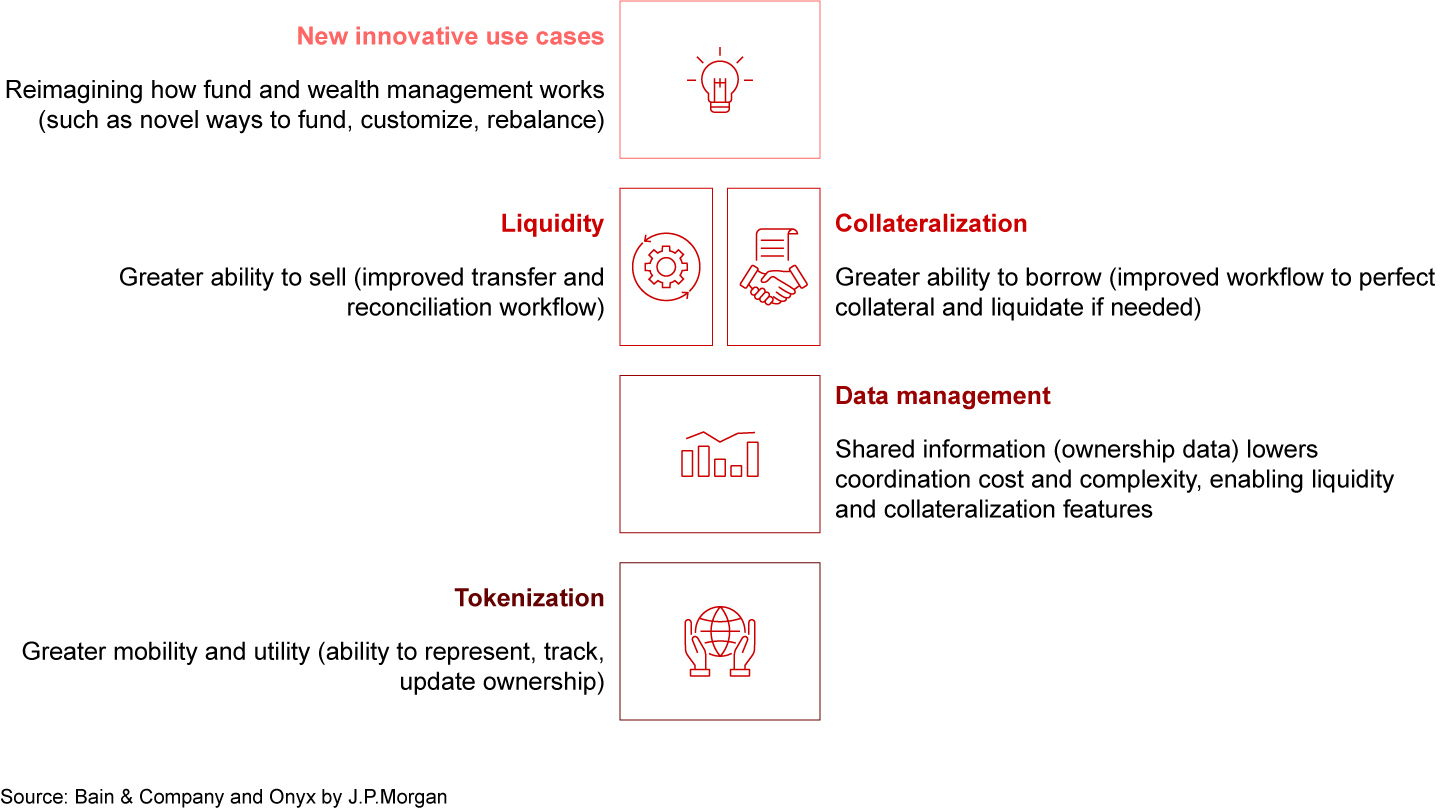
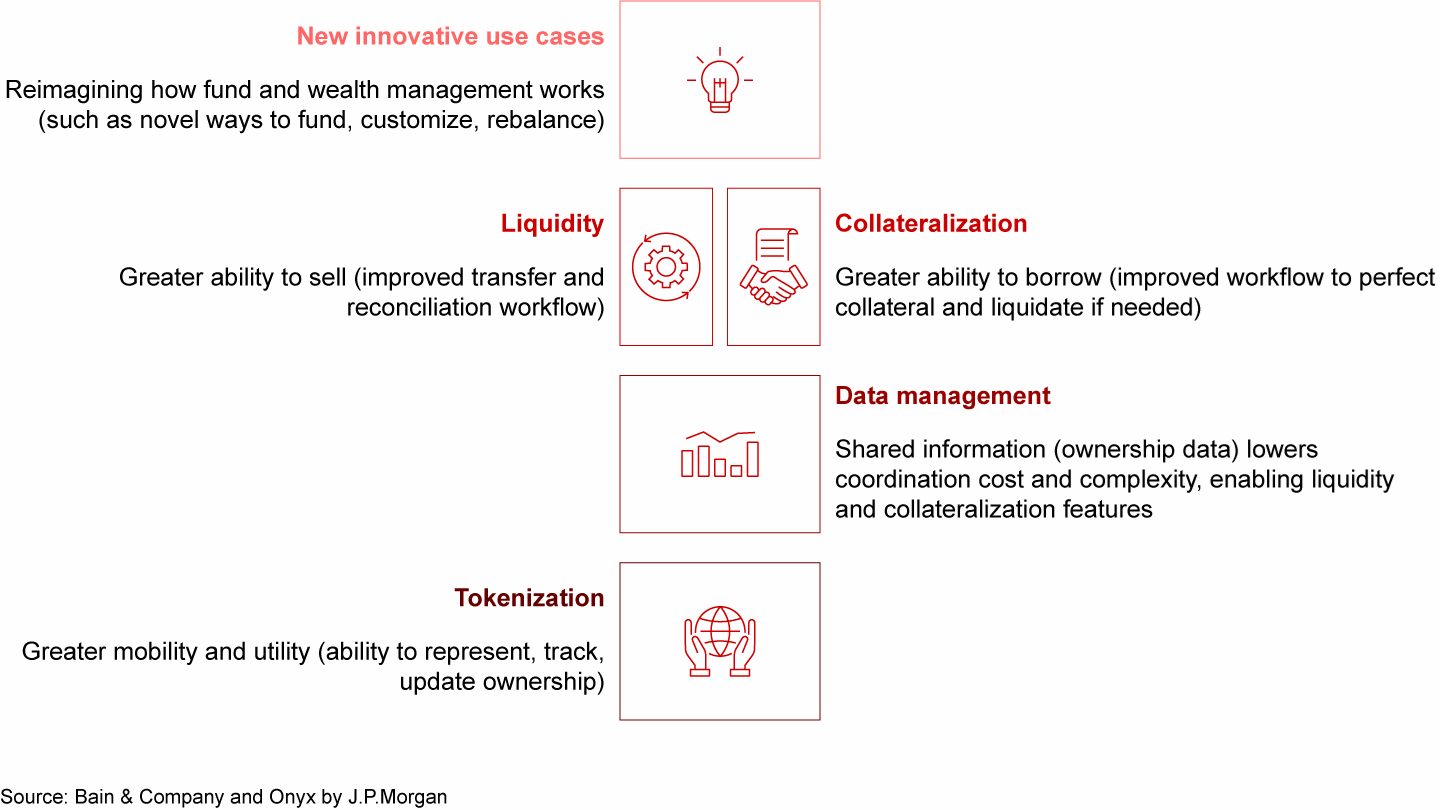
Data management: At its core, tokenization involves data standardization, workflow mutualization, and process automation. Streamlining the sharing of information boosts efficiency and is required to enable investor-friendly features. Mutualizing workflows and data reduces the need for manual reconciliation costs and complexity. Having ownership conferred automatically through smart contracts upon payment reduces the manual burden of recording and transferring ownership.
Liquidity: Selling an alternatives position is a manual, bespoke, and laborious process. Simplifying ownership recordkeeping could improve liquidity at scale and enable transactions of smaller ticket sizes, which are economically and operationally infeasible today. Tokenization could make illiquid investments more cash-convertible for individuals––overcoming a key barrier.
Note that enhanced settlement and better ownership records alone will not create liquidity; a sufficiently robust network of buyers is essential. This could come from existing holders or secondary funds that would have the opportunity to purchase the new supply of smaller positions in a familiar fund at a discount to net asset value. Or, potentially, a new class of market makers may emerge to provide liquidity in illiquid assets.
In addition, while tokenization could simplify the sale of illiquid assets, creating and sustaining liquidity requires aligned incentives across stakeholders. The sale of LP interests is an example where the incentives of the fund manager, distributor, and investor are not aligned. Although distributors and investors are generally open to selling LP interests, fund managers typically can veto sales of LP interests at a discount, which is where illiquid secondaries tend to price. While distributors could circumvent this scenario by establishing feeder funds, tokenization could offer an alternative solution: Smart contracts could embed fees that would be automatically paid when fund tokens change hands, providing a previously nonexistent source of revenues to fund managers and give an incentive for their participation in secondary transactions.
Collateralization: Only select firms offer collateralized loans against fund interests today and only to their wealthiest clients, given the effort required and underwriting risks involved. Tokenization can rectify this situation, owing to the following characteristics:
- Blockchain records could quickly and reliably prove provenance to establish ownership of collateral.
- Smart contracts and blockchain data can improve collateral monitoring by restricting token transfers, which is critical for loans collateralized by actively distributing funds. Consider a loan collateralized by a PE fund holding. Currently, there isn’t an intuitive mechanism to monitor fund holdings until the repayment of the loan to ensure proper collateral is in place. Therefore, if a fund distributes capital, the investor (the borrower) can effectively walk away with the distribution from the manager, while the lender is left with no collateral securing the loan.
- Enhanced liquidity through secondary markets could mitigate illiquidity risks should a lender need to sell their collateral and convert it to cash.
Innovative use cases: Data management, liquidity, and collateralization form the foundation for new capabilities that are otherwise difficult or impossible to implement today. Such new capabilities could include the following:
- Tokenizing underlying investments (e.g., individual company shares within a PE fund) to enable partial divestments;
- Negative screening (for instance, limiting exposure to the oil and gas industries) or positive screening, such as ensuring an environmental, social, and governance focus;
- Programmatic rebalancing of discretionary model portfolios; and
- Automating capital calls.
Two such transformational capabilities that could be enabled by tokenization are:
Automating capital calls: Capital calls are a significant point of friction in alternatives today since they are unpredictable, time-sensitive, and manual. The process requires forecasting and having precise liquidity levels to avoid missed capital calls (which would result in penalties or losing access to the fund) or setting aside more capital than called (which results in a cash drag and the opportunity cost of deploying cash elsewhere). In a future state where cash is kept on chain, tokenization could automate this process, improving the investor and advisor experience while reducing the need for reconciliations.
Beyond simply improving the current state, tokenization could also create a new paradigm for capital calls. If an investor commits capital to a PE fund, they could temporarily invest the same amount into a liquid tokenized investment vehicle that aligns with their overall financial goals. When the PE fund calls capital, a smart contract could enable the automatic redemption of the liquid tokenized investment, using proceeds to satisfy the capital call. This could be done with limited human intermediation and serve the dual purpose of automating the capital call process while eliminating the cash drag and opportunity cost associated with the current subscription process—benefiting both managers and investors.
Scalable customization: Once the foundational layers are in place, smart contracts could enable scalable customization of tokenized portfolios. These could include funds of funds focused on alternative investments or blended discretionary portfolios combining tokenized traditional and alternatives funds. (See Onyx’s recent report: "The Future of Wealth Management: Ultra-efficient portfolios of traditional and alternative investments powered by tokenization.")
Blockchain-based discretionary portfolios could revolutionize the wealth management industry by enabling automatic, ongoing rebalancing and harmonizing the treatment of different asset classes. This could allow alternatives to be included in discretionary model portfolios, improving the overall quality of client portfolios and providing a competitive edge for pioneering wealth managers.
In the longer term, alternatives managers could also tokenize underlying investments (as opposed to LP interests) to better distribute individual deals or access asset-backed financing. While co-investments and individual deal distribution exist today, tokenization could enable a deeper degree of personalization and customization. For example, an investor whose wealth is concentrated in a software business could work with an advisor to build a bespoke PE portfolio while avoiding further tech exposure.
While the initial benefits of tokenization may accrue to individuals, mass customization aids institutions as well. Consider asset management firms that build customized portfolios of alternatives for large institutions. These firms could leverage scalable, transparent platforms to simplify manual processes, enabling them to reinvest in higher-value functions like manager due diligence.
Overall, tokenization could address persistent frictions around ease of investing, enhance exit timelines, support broader borrowing against holdings, and enable customizable portfolios. However, tokenization will not address all aspects of the alternatives investment lifecycle (see Figure 6). Investor onboarding, AML/KYC checks, and reporting requirements could be improved by complementary technological solutions. Accreditation requirements such as those described in Section 3(c)(7) of the Investment Company Act of 1940 in the US, which provide stringent guidelines on the eligibility of individuals investing in nonregistered alternatives, would remain in place regardless of how the investment is accessed.
Tokenization can address many but not all barriers to broader adoption of alternatives by individual investors
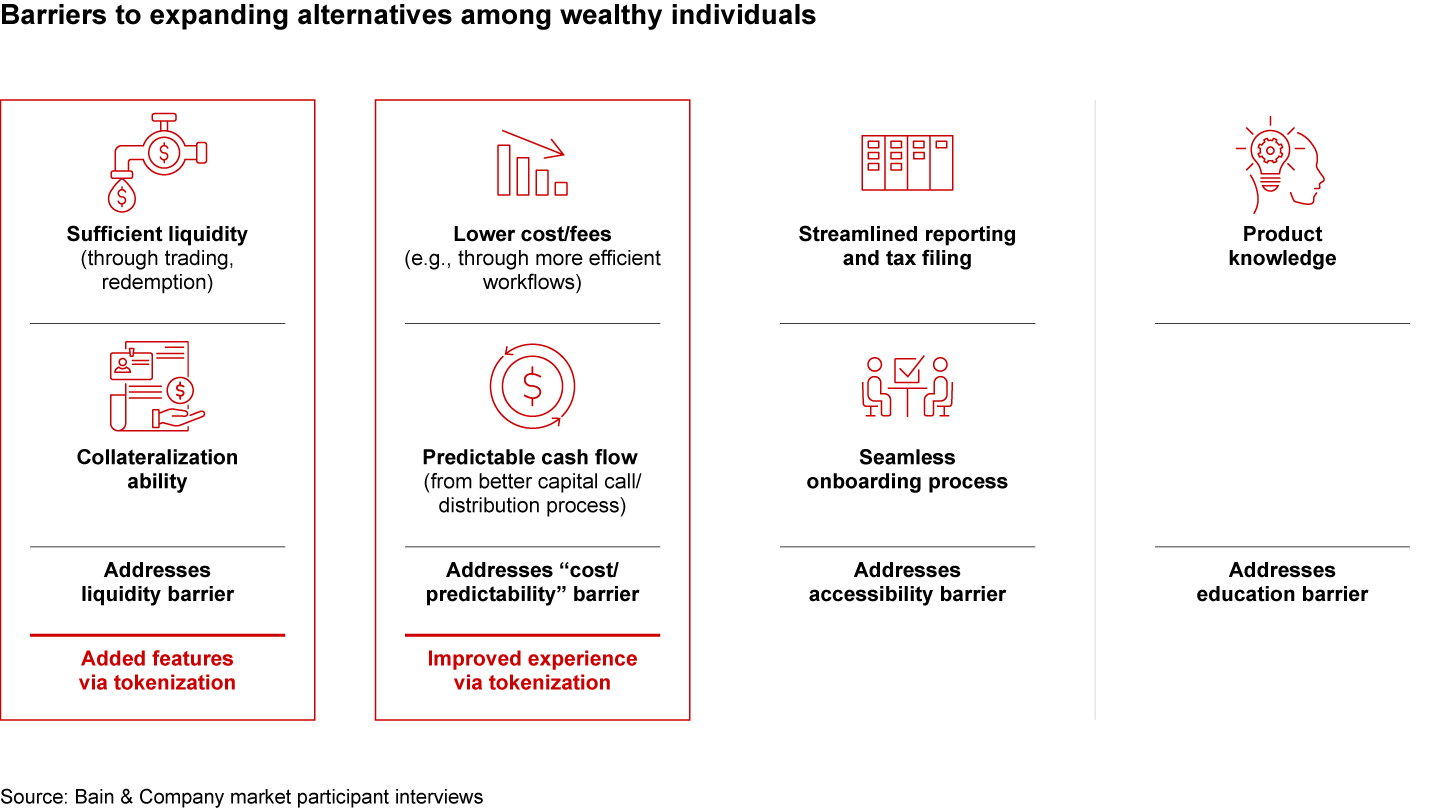
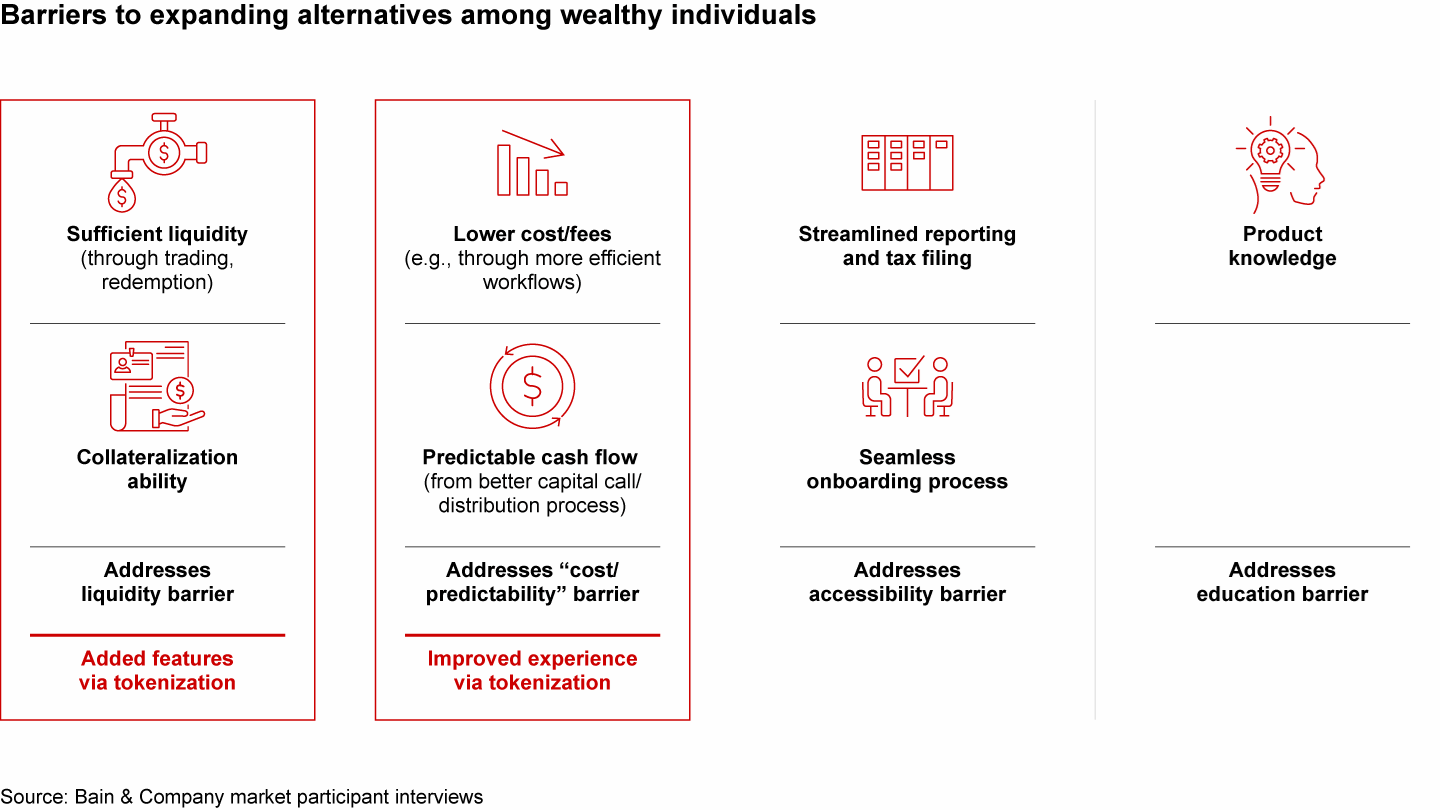
Tokenization could unlock a potential $400 billion revenue opportunity
A markedly improved investor experience and additional features could enable more widespread adoption of alternatives by eligible individuals while providing new streams of revenue and cost efficiencies for fund managers and distributors. The incentive to introduce tokenization is compelling: We estimate the full potential opportunity as approximately $400 billion in additional annual revenue.
This calculation flows from our assumption that wealthy investors’ alternatives allocations could increase from the current approximately 5% to 20% (market participants interviewed cited 15% to 20% as a reasonable allocation). This could result in the addressable market growing from $4 trillion to $16 trillion (high-net-worth individual wealth of $80 trillion multiplied by an incremental allocation of 15% (see Figure 7)). The bulk of the opportunity stems from increased distribution and assets under management as companies across the value chain generate incremental fees, though new revenue from liquidity markets and collateralized loans could account for up to $30 billion in additional annual revenues. New revenues would accrue mainly to fund managers, wealth managers, and wholesale platforms, with additional benefits to other firms such as fund administrators and transfer agents. The details are as follows:
Fund managers’ $270 billion opportunity: Fund managers may attract more capital by expanding their investor base, leading to increased assets under management and revenues from management fees and carry. New revenue streams may arise from secondary transactions or partnerships with distributors, while administrative simplification could also generate cost savings.
Wealth managers’ $100 billion opportunity: Wealth managers could benefit from broadened distribution and revenue share arrangements with fund managers. Higher secondary trading and collateralized lending provide additional revenue upside, while simplified operations could also enable wealth managers to flatten the marginal asset servicing costs for every additional investor. First movers could differentiate on technology, thereby gaining early market share and customer loyalty.
Wholesale platforms’ $30 billion opportunity: Wholesale platforms that differentiate themselves from competitors can expect to expand assets under management, secondary transaction revenue, and potentially other fund services. These providers also stand to gain from administrative and operational simplification.
Fund administrators’ and transfer agents’ $5 billion opportunity: These firms, along with software providers that adopt tokenization solutions, could increase market share, asset servicing revenues, and profit margins through cost efficiencies. Simplified operations could help unlock scale and value across the entire investment lifecycle.
Methodology for the $400 billion revenue opportunity
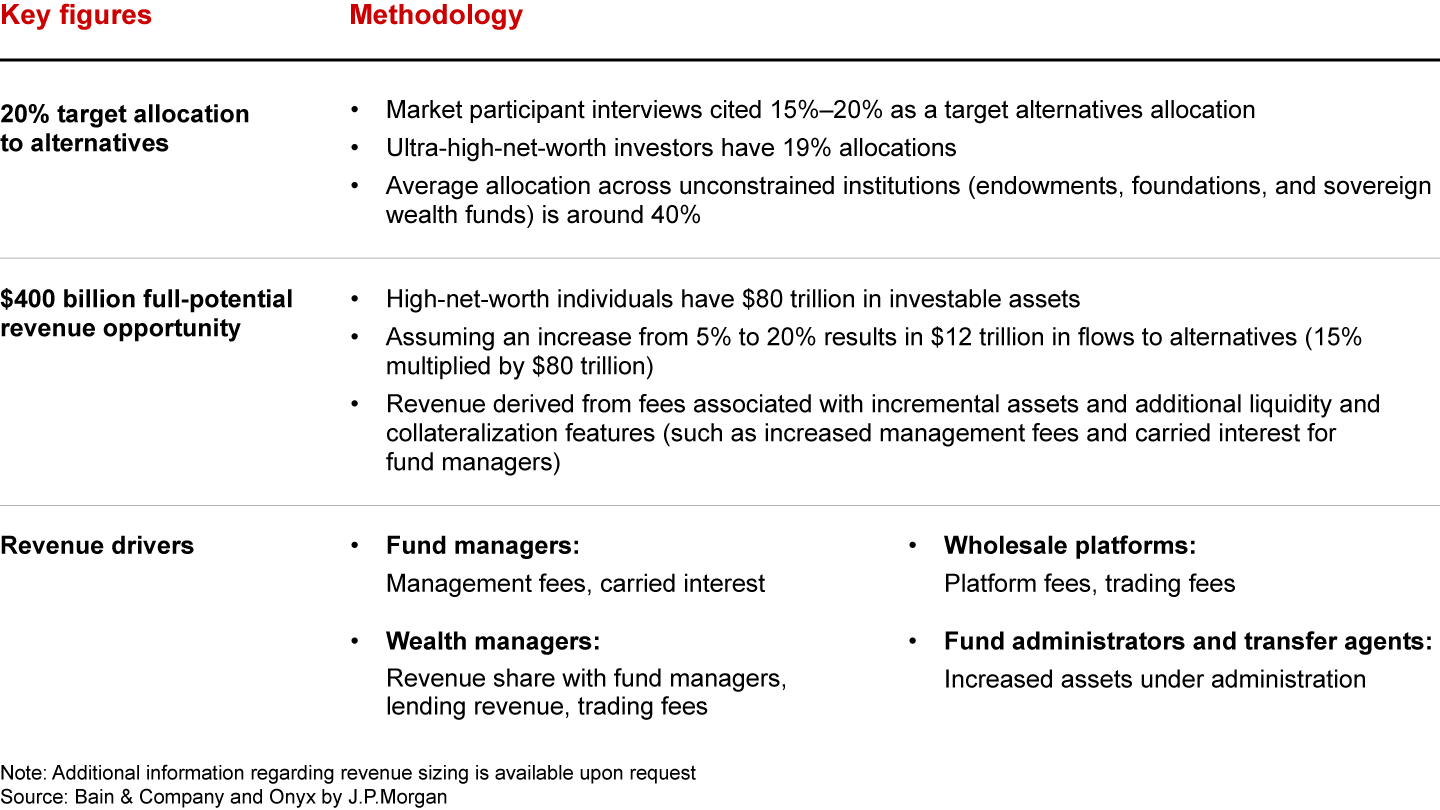
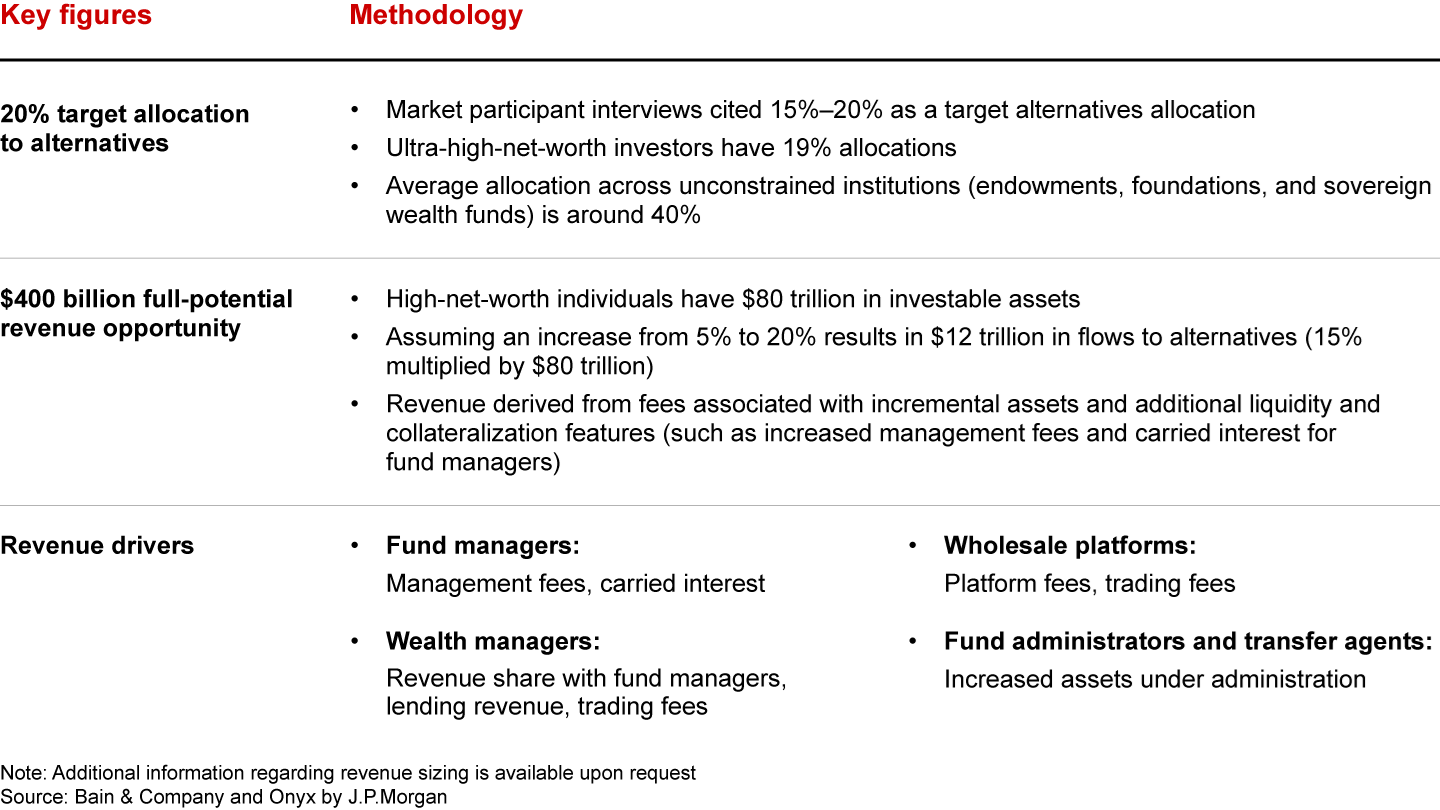
Establishing the pathways to tokenization
For the industry, progressing beyond proofs-of-concept and small experiments will require a thoughtful distribution and implementation model. Realizing the full potential of tokenization may entail greater industry coordination and multiyear commitments. Commercially successful tokenization efforts will likely come from incumbent firms evolving their infrastructure, rather than from emerging challengers. However, early successes could flow from meaningful collaborations between these two groups.
With these dynamics in mind, several pathways could lead to wide-scale tokenization of alternatives and their broader distribution to individuals. Specifically, initiatives could be led and defined by different participants in the alternatives value chain: Fund managers, wealth managers, wholesale distribution platforms, or industry consortia could all step forward as initiative leaders to spur adoption. In this context, initiative leader refers to the participant or consortium that would lead or coordinate the tokenization solution’s development, governance, and operation, including defining token standards and technology choices.
Each tokenization model has different implications in terms of which specific capabilities a firm needs to develop, their role in the value chain, and the resulting economics. Models led by wealth managers and wholesale platforms appear to be the most straightforward and promising, as they can design a system that enables a common set of features across their fund offerings, and with extensive investor relationships, these groups may be best positioned to spur adoption. For large distributors, even a private tokenized marketplace deployed exclusively to their client base could sufficiently unlock benefits such as enhanced liquidity and customization, providing a new competitive edge. Below are the details of all such models:
Wealth manager-led: Wealth managers are perfectly positioned at the intersection of supply and demand. Their demonstrated ability to raise capital could enable them to persuade alternatives managers to participate in tokenization initiatives. In situations where fund managers are less receptive, wealth managers can create tokenized feeder funds to build their roster of on-chain funds and demonstrate benefits to fund managers over time. On the investor side, wealth managers serve as trusted advisors and can help educate clients on the benefits of tokenized funds, while providing an improved investment experience. Wealth managers’ relationships, credibility, and advisory status provide advantages throughout the value chain. As a result, they have the foundation to propel market growth, spur broader tokenization of alternatives, and increase alternatives distribution to individuals.
Wholesale-led: Wholesale platforms could also emerge as leaders. Like wealth managers, they connect funds to investors and distributors and benefit from diverse product shelves, enabling them to identify offerings conducive to tokenization. Their existing focus on technology and user experience provides a meaningful head start. If properly implemented, the familiar self-service user experience coupled with added features could lead to a higher adoption rate of alternatives, driven by tokenized investment offerings.
Fund manager-led: A key requirement for successfully broadening alternatives access to individuals lies in distribution channels. Fund managers have an advantage in that they manufacture alternatives products; however, they typically partner with distributors to market these products. As opposed to setting up direct-to-investor channels, leveraging distributors is a lower-cost approach for managers and is more consistent with how individuals invest in alternatives today. Many fund managers have already taken the fund manager-led approach by tokenizing smaller funds, so we see these initiatives achieving the most success where fund managers find and partner with technology-forward, well-established distribution partners.
Consortia-led with ecosystem-driven standards: Standardized market infrastructure could profoundly affect alternatives by aligning participants on features, efficiency, access, and liquidity. Interoperability solutions that enable connectivity across blockchain networks could also play a role in a consortium approach. However, ecosystem-led approaches seem unlikely to proliferate given challenges with governance and incentives alignment, combined with the potential difficulty getting agreement on standards and features.
Start small, establish proof points to create buy-in and adoption
A pragmatic, step-by-step approach removes the need for material upfront investment and allows for a more targeted approach to unlocking benefits. Tokenization solutions don't necessarily require overhauling existing systems, strategies, and relationships. With off-the-shelf solutions available, firms could start with targeted applications focused on distribution, transaction management (subscriptions and redemptions), or capital call pain points for a few investors. These narrow use cases could demonstrate tangible benefits before scaling tokenization more broadly.
Wealth managers and wholesalers should first identify the biggest pain points in delivering alternative investments to clients. The concept of tokenization can prompt foundational questions as to why current models persist despite limitations. Beginning the analysis to uncover constraints in current systems and processes would likely reveal the opportunities that tokenization could introduce through cost reduction and new revenue. Both groups benefit from their proximity to individual investors and their diversified shelf of offerings, making it easier to find familiar and receptive partners and clients in this endeavor.
It is also important to consider the jurisdiction in which to explore tokenization. A number of countries have fewer regulatory requirements or lower investor accreditation thresholds relating to individual investors. Singapore, for instance, requires either net worth over SGD 2 million, net financial assets over SGD 1 million, or income of SGD 300,000 or greater (prescribed by the Monetary Authority of Singapore, Securities and Futures (Classes of Investors) Regulations 2018). It is also worth noting that most high-net-worth wealth resides in the US, according to the Credit Suisse Global Wealth Report 2023. Therefore, starting in the US may offer the best return on investment despite higher initial hurdles.
Fund managers starting out should first identify their goals. Firms that want to take meaningful steps into tokenizing their products might first want to tokenize a portion of a widely distributed flagship fund vintage, potentially after a smaller experiment, such as tokenizing one feeder fund with one wealth manager. Implementing tokenization via a share class in an existing structure rather than a feeder or new fund is likely the most efficient and client friendly. Another alternative could be to pursue tokenization internally with employee investment offerings—providing the added benefit of gathering useful, actionable color on the life cycle activities of a tokenized fund without the risk of a poor client experience.
Regardless of approach, firms should take the following actions to best position their initiatives for success:
- Dedicate time and resources to understand the technology’s capabilities and limitations. Leverage existing innovation or corporate strategy teams to explore trends in tokenization and how the technology could be applied within the firm.
- Take inventory of existing processes and identify which pain points limit the growth of alternatives to individuals. Spend time with the professionals who deliver alternatives to individuals in order to validate hypotheses. Explore new designs for existing processes to achieve greater scale.
- Understand how to serve the unique client base better. Bain survey data indicates that liquidity, transparency, and access are three key reasons that individuals are underinvested in alternatives, but these findings should be validated within a firm’s own client base. Begin discussions with key clients to understand which potential features could be added to increase allocations to alternatives.
- Define success for the initiative with well-defined milestones. What parts of the existing process are in scope, and by when does the firm expect to demonstrate potential benefits? If successful, does the project extend to additional aspects of the investment process, or does the firm broaden its focus to additional funds?
- Understand what is and is not possible under current regulations and identify a suitable jurisdiction for early use cases. Plan for other key considerations such as obtaining requisite licenses, filling gaps in technological capabilities, deciding on the most appropriate target fund and access point, and implementing new workflows.
- Upskill relevant staff to educate and support clients serving as early adopters. With complexity already being a barrier for individuals’ access to alternatives, adding the concept of tokenization could add nuance to client conversations. Client-facing professionals should be educated on the benefits of tokenization and be prepared to handle client objections.
Tokenization has the potential to change how alternatives work by making it easier to distribute and invest in funds and adding investor-friendly features to help bridge the gap between alternatives managers and individuals. Tokenization will not lead to a complete democratization of the asset class, such as access for retail investors, liquid 24/7 markets, or decentralized trading. Instead, it could make alternatives more accessible and desirable for high-net-worth individuals, potentially increasing allocations and consequently industry revenues by $400 billion annually. Given the sizable stakes, interested firms should develop their tokenization strategy and begin testing and learning to ensure they are well positioned for this emerging opportunity.

About Onyx
Onyx by J.P. Morgan is a global leader in banking-led blockchain, building next generation financial ecosystems that enable the seamless exchange of value, digital assets and information. Onyx’s deep understanding of financial services, emerging technology, and client businesses enables them to create reliable, effective infrastructures and products alongside clients to reimagine traditional business models.